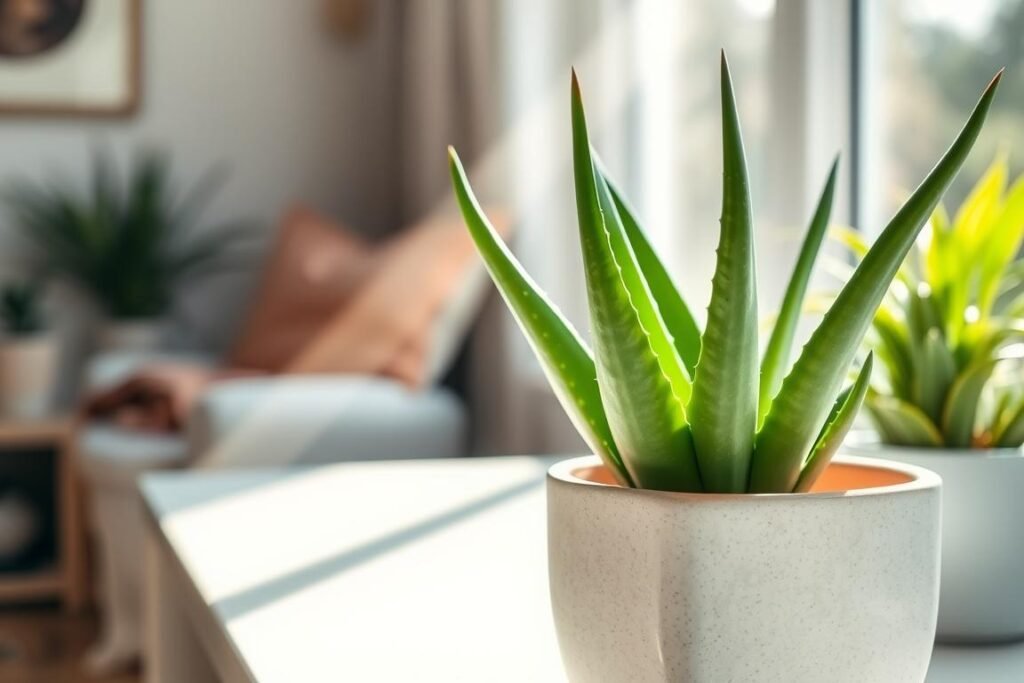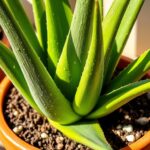As I look out the window, I see the sun’s rays on my aloe plant. It reminds me of how these plants need the right amount of light. Aloe plants come from dry places in Africa and the Arabian peninsula. They love lots of sunlight but can get hurt by too much.
It’s important to give your aloe the right amount of sunlight. This helps it stay healthy and not grow weak. If you know how much light your aloe needs, you can help it grow well.
Key Takeaways
- Aloe plants need at least 6 hours of direct sunlight a day to grow well.
- They also do okay with indirect sunlight and partial sun. But they like direct light best.
- Too much direct sunlight can cause sunburn and change the color of the leaves.
- Slowly get your aloe used to changes in light to avoid stress.
- Indoor aloe plants might need extra light to get enough sunlight.
Understanding Aloe Plants and Their Natural Habitat
Aloe plants come from dry, desert-like areas, especially the Arabian Peninsula. They grow under the shade of bigger desert plants. This helps them get the right amount of light.
Native Environment and Growth Patterns
There are over 500 types of aloe plants. They are divided into tree, shrub, and stemless aloes. Aloe vera is famous for its long, thick leaves and tall flower stalks.
These plants love hot, dry places. They need lots of sunlight for aloe to grow well.
Common Aloe Species for Indoor Growing
- Aloe vera: Known for its medicinal properties and thick, succulent leaves.
- Aloe variegata (tiger aloe): Featuring distinctive striped leaves.
- Aloe aristata (lace aloe): A compact variety that grows 8 to 12 inches tall, making it suitable for containers.
- Aloe polyphylla (spiral aloe): Recognized for its short leaves that spiral in a single direction.
Adaptation Features of Aloe Plants
Aloe plants have thick, waxy leaves and can store water well. This helps them survive in dry places. They also need the right sunlight for aloe to grow indoors.
How Much Sunlight Does aloes Need
Aloe plants are known for being tough and easy to care for. But, they need the right amount of sunlight to grow well. Knowing what light they need is key to their health.
Aloe vera plants love bright, indirect sunlight. They need at least 6 hours of light each day. The best spot is near a south-facing window with soft, filtered light. This light is like their natural home.
Even though aloes need a lot of sunlight, they can’t handle too much. Too much direct sun can burn their leaves. It’s important to find a balance to keep them happy.
| Aloe Light Conditions | Recommendation |
|---|---|
| Sunlight Tolerance | Bright, indirect sunlight for at least 6 hours per day |
| Ideal Placement | Near a south-facing window with filtered light |
| Direct Sunlight | Avoid prolonged exposure to prevent leaf sunburn |
By giving your aloe the right aloe sunlight tolerance and Aloe Light Conditions, it will thrive. A little bright indirect light is all they need. These plants are easy to care for and beautiful.
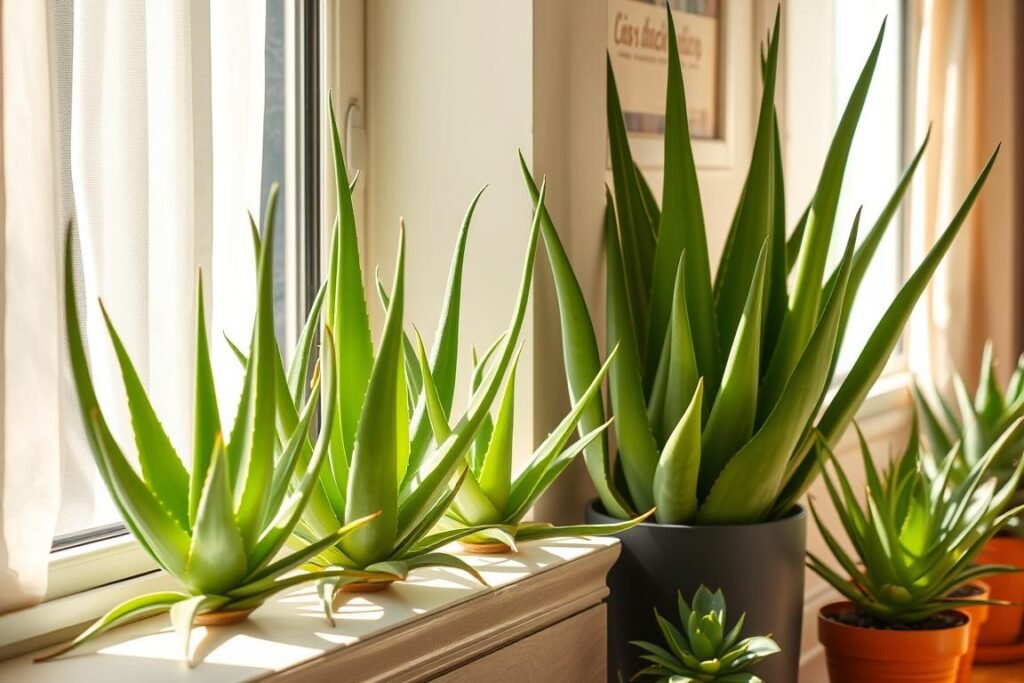
Direct vs Indirect Sunlight Requirements
Aloe vera plants love bright, indirect sunlight. This is like their natural desert home. Too much direct sunlight can hurt them. Knowing the right light is key to growing these plants well.
Understanding Light Intensity
Aloe vera likes light that’s not too strong. But, too much sun can make leaves turn red or brown. This means they’re getting sunburned. So, it’s important to find the right mix of light and shade.
Best Window Placement for Aloe
South-facing windows are perfect for aloe vera. They get lots of light but not too much sun. East or west windows are okay too, but you need to watch them more to avoid leaf damage.
Seasonal Light Adjustments
The light aloe vera needs changes with the seasons. In winter, they need more light. In summer, they might need less to avoid getting sunburned. Moving the plant with the seasons helps keep it healthy.
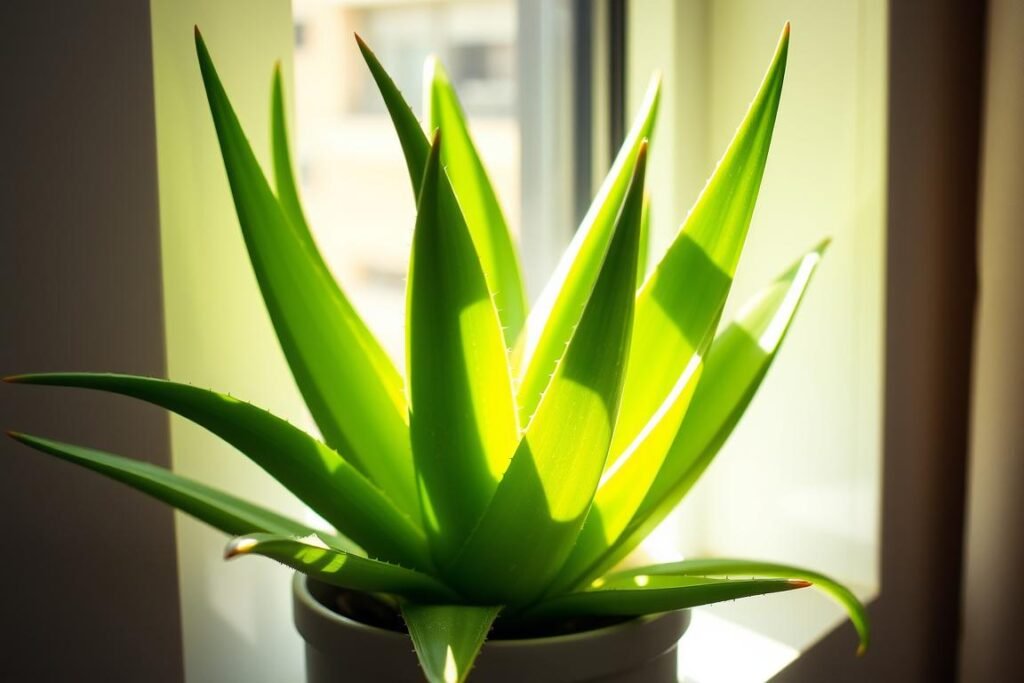
| Aloe Vera Variety | Sunlight Requirements |
|---|---|
| Aloe vera var. barbadensis | 6-8 hours of bright, indirect sunlight per day |
| Aloe vera var. chinensis | Partial shade with filtered sunlight |
| Aloe vera var. perryi | Morning sun with afternoon shade |
| Aloe vera var. nobilis | Bright, indirect sunlight for at least 4 hours |
“Aloe vera should be placed in bright, indirect light to prevent leaf burning. Direct sunlight can lead to sunburn, causing leaves to turn reddish or brownish.”
Signs of Inadequate Light Exposure
Light is key for your aloe plant’s health. If it doesn’t get enough sunlight, you’ll see signs it needs more.
Etiolation is one sign. It makes stems and leaves stretch out for more light. This can make them weak and not thick like a healthy aloe. Leaves might also turn pale or yellow because they don’t make enough chlorophyll.
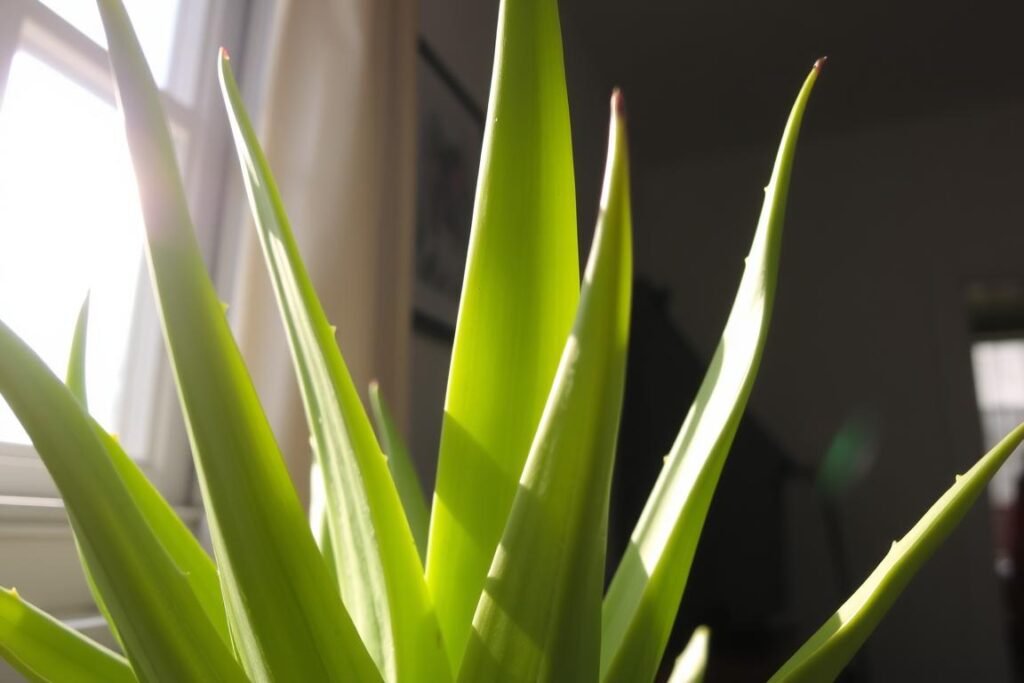
Too much sunlight is bad too. Leaves can turn reddish-brown or gray. You might see spots or patches. Leaves might also droop or curl.
It’s important to find the right light for your aloe. Watch your aloe closely. Move it to get the best aloe light exposure for its health and growth.
Protecting Aloe from Excessive Sunlight
Aloe plants are very strong. But, they can get sunburn if they get too much sun. Signs of sunburn include red or gray leaves and brown tips.
To stop sunburn, slowly get your aloe used to more light. Do this over 7-10 days.
Gradual Light Acclimation
When moving your aloe to a brighter spot, do it slowly. Start with a few hours a day. Then, increase the time over a week or two.
This helps the aloe’s leaves get used to more light. It keeps them from getting sunburned.
Using Natural Filters
If your aloe gets too much sun, use natural filters. Sheer curtains or plants can soften the sun’s rays. This gives your aloe the light it likes without getting sunburned.
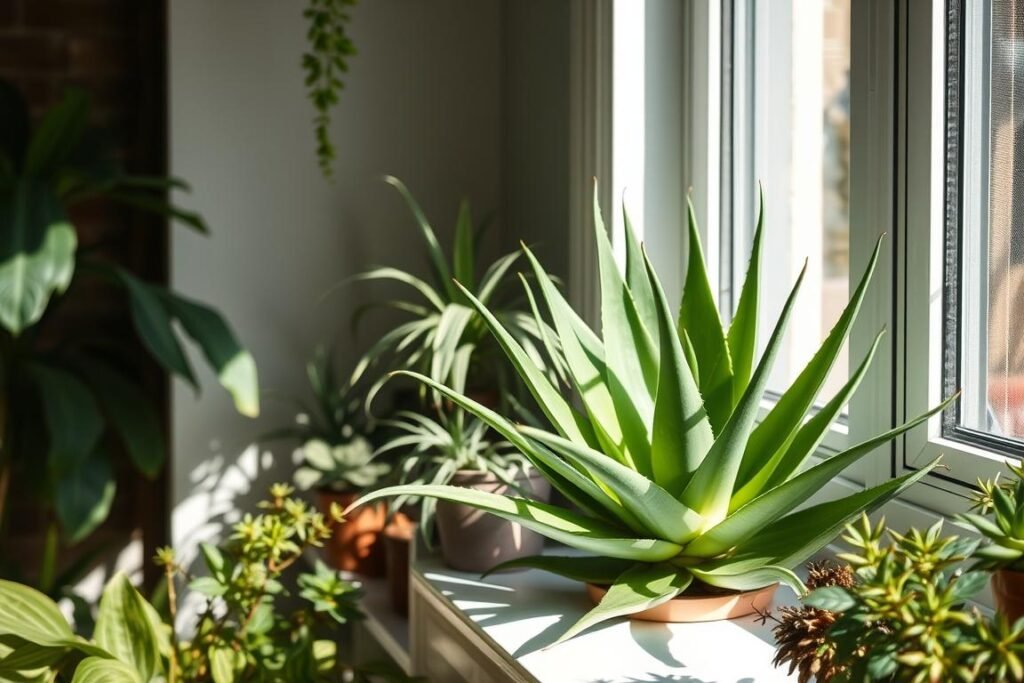
It’s important to have the right light for your aloe. By slowly getting it used to more light and using natural filters, you can keep it healthy. This works whether it’s indoors or outside.
Indoor Light Requirements and Positioning
Lighting is key for aloe vera plants indoors. They do best near south-facing windows. This gives them 6 hours of bright, indirect sunlight daily.
Direct sunlight can hurt them. It can cause leaf scorch. So, finding the right balance is important.
If your space doesn’t get enough natural light, use artificial grow lights. Fluorescent or LED lights work well. Just make sure they’re on for 12-14 hours a day.
As seasons change, you might need to adjust the light. Aloe vera’s needs can change too.
It’s good to rotate your aloe vera plant. This helps it grow evenly. It also stops it from leaning towards the light.
This keeps your plant healthy. It also stops Aloe Flop, a problem from not enough light.
| Lighting Requirement | Ideal Conditions |
|---|---|
| Natural Sunlight | 6+ hours of bright, indirect light near south-facing windows |
| Artificial Light | 12-14 hours of fluorescent or LED grow lights |
| Seasonal Adjustments | Increase light duration during winter months |
Knowing about succulent indoor lighting and aloe vera lighting requirements helps. You can make a great space for your aloe vera plants to grow well indoors.
Supplemental Lighting Options
When natural sunlight is not enough, artificial lighting helps. It gives your aloe plants the light they need. This helps them grow strong and look great.
Artificial Light Solutions for Aloe Plants
White fluorescent lights are good for aloe plants. Place them 6-12 inches above the plant. This helps them get the light they need.
LED grow lights are also great. They use less energy and last a long time. They give the right light for photosynthesis.
Ideal Light Duration for Aloe Plants
Aloe plants need 14-16 hours of light a day. This can be from the sun or artificial lights. A steady light schedule is key for their health.
Some aloe plants, like the Climbing Aloe, need 18 hours of light. Use timers to keep the light consistent. This is good for their health.
With the right lights, your aloe plants can thrive. Even in places with little sunlight. The right light and time help them grow well.
Seasonal Light Changes and Plant Care
I love taking care of aloe plants. They need changes with the seasons. In winter, from October to February, I water them less. This stops them from getting too wet and rotting.
But, they still need lots of light. They need 6-8 hours of sunlight every day to grow well.
In spring and summer, I water them more. This is because they drink more water when it’s warmer. I also watch how much light they get. I move them around to get the right amount of sun.
Knowing how much light aloe plants need helps them grow strong. I make sure they get the best light all year. This way, they do great inside or outside.
FAQ
What are the natural habitats and growth patterns of aloe plants?
Aloe plants come from dry places in Africa, the Arabian peninsula, and islands in the Indian Ocean. They have thick leaves to store water. These plants grow in the shade, getting filtered light from above.
What are some common indoor aloe species?
Common indoor aloes are Aloe vera, Aloe variegata (tiger aloe), and Aloe aristata (lace aloe). They have thick leaves and store water well. This helps them live in dry places.
How much sunlight do aloe plants need?
Aloe plants love bright, indirect sunlight. They need at least 6 hours of it every day. They do best in light that’s not too direct, like their natural home.
What is the ideal placement for an aloe plant indoors?
The best spot for an aloe plant is near a south-facing window. But, it should be protected from too much sun. East or west windows are okay too, but you might need to adjust the light as the seasons change.
What are the signs of inadequate light exposure for aloe plants?
If aloe plants don’t get enough light, they stretch out. This makes them weak. Their leaves might turn yellow because they can’t make enough chlorophyll.
How can sunburn be prevented in aloe plants?
To avoid sunburn, slowly get your aloe plant used to more light over 7-10 days. You can use curtains or plants to soften the light. This helps protect your aloe.
What type of artificial lighting is suitable for aloe plants?
White fluorescent lights or LED grow lights work well for aloe plants when it’s dark. Place them 6-12 inches above the plant. Turn on the lights for 14-16 hours a day.
How do seasonal changes affect aloe plant care?
In winter, water your aloe less but keep the light the same. In spring and summer, water more as the days get longer. You might need to move your aloe or change its light spot with the seasons.

